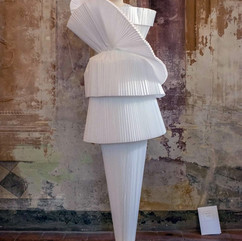Origami technique
- Emiliano Galigani

- May 3, 2024
- 3 min read
Folding paper to combat anxiety and stress
Origami is a Japanese term that has long been part of our lexicon. Almost everyone is familiar with the art of paper folding that bears this name, and many, perhaps even as children, have tried their hand at this technique during school years or in their free time. The term refers specifically to the action of folding paper: in Japanese, "ori" means fold, and "kami" means paper. Hence the description of this practice, which allows for the creation of figures, objects, and compositions using only paper, folded in such a way as to assume ever-changing forms.
Children have likely attempted at least once, perhaps under the guidance of teachers, to fold paper to create flowers or animal shapes. But this activity is not just for children; for many, it's a way to express their creativity even in adulthood. In fact, as one grows and becomes more familiar with origami, it's discovered that it's possible to create anything with paper, including objects and home decor.
Paper is the raw material, and the only one, that needs to be worked with, so the choice of which paper to use is crucial. After the initial attempts, it becomes clear that paper that is too thin should be avoided, as it is fragile and wrinkles too easily when folded, as well as thicker cardstock, which is difficult to fold and laborious to work with. The most suitable paper is smooth, sturdy yet lightweight, easy to fold but not prone to wrinkling.
However, the word "kami," with a different ideogram but the same pronunciation, also means spirits or deities: this overlap in meaning inexorably links the art of origami with spirituality, with the pursuit of the divine, and gives this technique a sacred significance. The Japanese technique of origami is closely connected to the spirituality of Zen. By folding for a sufficiently prolonged period and without any haste, one achieves a state of deep relaxation with a reduction in heart and respiratory rate. By concentrating on the model being folded, one reaches a state of suspension of logical and rational thought, reducing inner dialogue, and bringing attention to the moment being experienced, valuing every single movement of the hands and every fold.
Origami encompasses concepts such as interdependence (each form arises from a defined sequence of folds, with each fold necessary for the execution of the next fold, and each fold composed of preceding ones) and impermanence (the shape of the model constantly changes from beginning to end, while the substance of the paper remains unchanged), typical of Zen philosophy. Origami is a pursuit of beauty, understood as the search for harmonious and balanced forms that persist in the mind of the folder. It can help combat stress and anxiety, stop time, and aid in emptying the mind. Through Origami, a high degree of socialization is almost "automatically" achieved, and it is not uncommon to observe individuals considered "disadvantaged" excelling in the technique, leading to recovery and increased self-esteem.
For many years, the Japanese art of paper folding has also found its way into the world of fashion, where the technique has been used to create garments with a perspective and three-dimensional effect. Designers and artists have ventured into creating clothing with various geometric shapes, resembling paper sculptures, using this technique to create decorative folds on shirts, skirts, dresses, bags, and wallets. Some believe that silk is the most suitable fabric because it holds folds well and withstands the heat of the iron. Other designers, however, have embarked on the endeavor of using paper itself to create hand-folded costumes. Among these, we invite you to read Cinzia Verni's Lubica Story, a paper artist with a special focus on fashion.
All the photos in this article are part of the LubicaHistory archives from 2018, 2021, and 2022.
Liang Haisheng & Paper Life with "Triangle Folded Paper Lantern" (2018)
Joe Wong with "Vase" (2018)
Marco Zecchinato with "Remnants II" (2018)
Ankon Mitra with "The Sights and Sounds of the Cosmos" (2018)
Papier Atelier with "In Between" (2021)
Philipp Blume with "Samurai" (2021)
Cinzia Verni with "Similitude of Pleats" (2022)
(For more on the technique of origami, read Anita Cerpelloni's Lubica Story)



















Comments